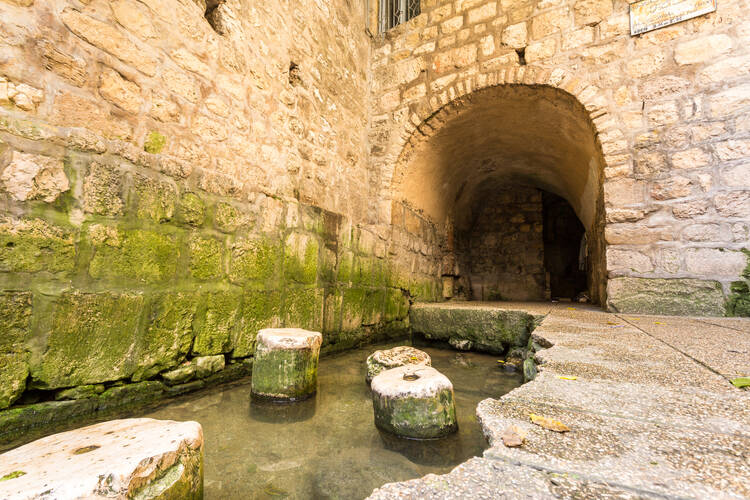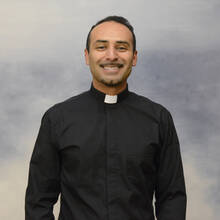The symbols we need in Lent: water, light and life
During the liturgical season of Lent, the church turns to the Gospel of John to strengthen the journey of the faithful seeking baptism and other sacraments at the Easter Vigil. The Gospel passages selected to aid their path into full communion include the Samaritan woman at the well (Jn 4), the healing of the man born blind (Jn 9) and the raising of Lazarus from the dead (Jn 11). These passages reinforce that the symbols of water, light and life are essential to the spiritual journey. The goal of this Lenten path is restoration between God and his creation.
If you were blind, you would have no sin; but now you are saying, ‘We see,’ so your sin remains. (Jn 9:41)
Can you think of exclusions in society that have become normalized?
Who comes to mind today that seeks full incorporation into the church?
Where can Jesus heal your own spiritual blemishes?
In this Sunday’s Gospel, the healing of the blind man highlights more than just the restoration of sight. In fact, his blindness appeared to exist specifically for this great sign. “Neither he nor his parents sinned,” explains Jesus, “but it is so that the works of God might be made visible through him” (Jn 9:3).
There is a parallel between this Sunday’s Gospel passage and last Sunday’s passage of the woman at the well, which also highlights impurity, water and restoration. In last week’s Sunday Gospel, the Samaritan woman needed life-giving water and found this in Jesus. The woman was marginalized from her community, evident by her lonesome trip to the local well at noontime, while most people would have collected water in the morning. Jesus engages the woman in one of the longest theological conversations found in the New Testament. In the end, she is restored to the community, which in turn discovers the Messiah through her sharing of this encounter.
Jesus is the ritual cleansing greater than the waters of Siloam for the man born blind and excluded from full societal participation.
This week’s Gospel also highlights the religious-social exclusion of the man born blind. Blemished priests, for example, although they could enter the sacred precincts and eat from the most sacred offerings, were excluded from entering the holy of holies or from ascending the altar stairs. Thus, one finds in Leviticus that several blemishes prohibit a priest from those specific sacred spaces. The list of those excluded include the blind, lame, one who has a split lip, a limb too long, a broken leg or arm, a hunchback and even someone with crushed testicles (see Lv 21:18-21). This might look silly to the contemporary reader, but even modern societies find ways to exclude by a set of different standards like race, color, gender, level of intelligence, esteem, orientation and religion.
The blind man in today’s Gospel passage is not an Israelite priest, but there is evidence that general societal prejudices attempted to label the man as inherently sinful. The man is trying to share his experience of restoration but some religious professionals will hear none of this. “You were born totally in sin,” the Pharisees replied, “and you are trying to teach us? Then they threw him out” (Jn 9:34). There are also questions of whether the parents passed on their sin to their son. What Jesus sees, in contrast, is the opportunity for the works of God to be revealed.
It is easy to imagine the blemish of a broken arm to heal itself naturally and thus restore said individual to Temple worship in Jerusalem. Not so with a man born blind from birth. The gravity of his blemish is congenital, he is excluded from full religious incorporation into the faith from birth to death. After Jesus’ miraculous healing of the blind man, he orders the man with fresh sight to go wash in the waters of Siloam, a place of ritual cleansing. Who knows how many violations of purity the blind man committed due to not seeing where to walk, what to touch and who to interact with on a daily basis? His need for full cleansing is complete with the ritual bath. His blindness, however, could only be cleansed by Jesus’ touch. The man born blind is restored to himself as well as his community.
In the past two Sundays, the metaphor of life-giving water is said to come from the anointed one through the Spirit. Jesus is the spring that never runs dry for the Samaritan woman marginalized from her community. Jesus is the ritual cleansing greater than the waters of Siloam for the man born blind and excluded from full societal participation. In his embodiment of restorative virtue, Jesus fulfills the requirements found in the prophetic books for the anointed one, “Then the eyes of the blind shall see'' (Is 35:5). There will always be a habit within cultures to marginalize and excommunicate someone from within a sphere of society. Jesus shows his anointed mission in the virtue of restoration.








